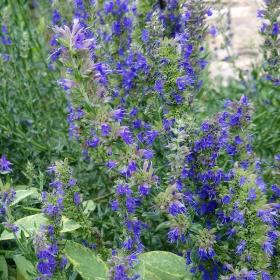Hyssop (Hyssopus officinalis Lam.) is a name of Greek origin. The herb was used for cleaning sacred places. It is alluded to in the Scriptures: "Purge me with Hyssop, and I shall be clean."
Hyssop's history can be traced to ancient times, from purifying temples to cleansing lepers. The Persians used distilled hyssop water as a body lotion to give a delicate color to their skin. Hippocrates recommended Hyssop for chest complaints.
Hyssopus is a perennial herb of bushy habit. It grows up to 50cm tall, with square, richly branched, and densely leafy stems covered in downy hair. The symmetrical flowers are blue-violet, appearing in groups of three to seven in the upper axils from July to October, forming single terminal spikes. The Hyssop's blue spires bloom late in the summer and are an excellent bee attractant.
